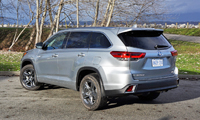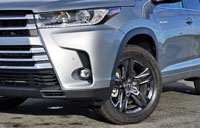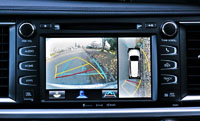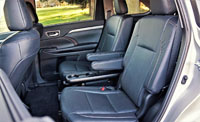
What do you think of the new 2020 Highlander? It was introduced a few months ago at the New York auto show and will go on sale in December this year, just in time for Christmas (or Hanukkah, Kwanzaa, Saturnalia, and Omisoka, take your pick). It pulls plenty of styling cues from what I think is the better looking 2014 through 2016 version of the third-generation Highlander currently available, the newer 2017 through (as-tested) 2019 variation a bit too over-the-top when it comes to its chrome-laden mega-grille for my tastes, but to each his, her or hir own. I find the 2020 much more attractive, and believe it will serve both Toyota and the Highlander’s faithful well for years to come.
That 2014 Highlander I just referenced was a major milestone in Toyota design and refinement, its interior wholly impressive. The Matt Sperling-designed model, which saw its maximum seat count grow from seven to eight in base trim, found greater success due to its more rugged Toyota truck-inspired grille and lower fascia combo, while this fancier Lexus look hasn’t fared quite as well, hence (I’m guessing) the move back to simpler, cleaner, more classic lines.

Probably due more because of the auto market’s general move from cars to crossover SUVs, Highlander sales grew by 17.70 percent from 2016 to 2017 in Canada, but then deliveries eased 4.06 percent through 2018 before plunging by a whopping 17.70 percent (strangely the exact number the model gained two years ago) over the first six months of 2019. In a market that’s constantly being touted as SUV crazy, why has Toyota seen such a downturn in Highlander popularity? Could it be styling?
Before jumping to conclusions, a deeper look at the entire mid-size crossover SUV segment’s sales chart shows the Highlander as far from alone in this downward slide. In fact, this entire class experienced a 7.66 percent decline from 2017 to 2018. Specifically, of the 24 crossovers/SUVs now selling into the mid-size volume segment (including tall wagons such as the Subaru Outback, two-row crossovers like the Hyundai Santa Fe, three-row models like this Highlander, and traditional body-on-frame SUVs like the Toyota 4Runner), just 8 saw upward growth while 10 swung to the negative, while another five only grew because they were totally new and had no 2018 sales to be compared to.

As to how the Highlander fits within the general mid-size positive and negative crossover SUV pecking order, check out this breakdown ranking all 24 rivals as to popularity from January through June 2019, with each model’s sales followed by its growth or shrinkage rate in parentheses: Ford Edge at 8,709 units (+9.05); Hyundai Santa Fe at 8,225 (-11.51); Jeep Grand Cherokee 8,033 (+26.94); Kia Sorento at 6,965 (+0.32); Chevrolet Blazer 6,812 (sales began January 2019); Nissan Murano 5,062 (-8.00); Toyota Highlander 4,985 (-17.70); Dodge Durango 4,900 (+54.14); Subaru Outback 4,212 (-4.77); Ford Explorer at 4,100 (-45.14 because of its 2020 model changeover); Volkswagen Atlas 3,679 (+14.01%); Honda Pilot 3,477 (+22.43); Toyota 4Runner 3,398 (+10.18%); Nissan Pathfinder 2,597 (-10.63); Chevrolet Traverse 2,443 (-16.36); GMC Acadia 1,956 (-3.88%); Ford Flex 1,812 (+115.71, bizarre, right?); Subaru Ascent 1,721 (sales started in January 2019); Mazda CX-9 1,573 (-7.58); Dodge Journey 1,488 (-39.19); Kia Telluride 1,072 (sales began in March 2019); Honda Passport 921 (sales initiated in February 2019); Hyundai Palisade 180 (sales started in June 2019); Volkswagen Touareg 17 (-96.91 du to being discontinued).
I wouldn’t expect to see all of these models slotting into the same order by year’s end, due to redesigns (the new Explorer should regain much of its lost ground, as it was third last year, while the 2020 Highlander should receive a nice bump too, albeit during the following calendar year) and totally new models should help swell the ranks (Chevy’s new Blazer sales are very strong), but the leading brands will probably maintain their leadership for reasons we all know too well, one of these top sellers being this very Toyota Highlander.

For the remainder of the year Toyota’s mid-size crossover success hinges on the current Highlander, which should be able to hold its own well enough. The well-proven model didn’t get a lot of help from its product planning team, however, with just one itty-bitty upgrade to wow prospective buyers. That’s right, a lone set of LED fog lights replacing previous halogens is the sole excitement for 2019, and Toyota didn’t even change their shape from circular to anything else (stars would’ve been fun).
I had a 2019 Highlander Hybrid Limited on loan for my weeklong test, incidentally, oddly coated in identical Celestial Silver Metallic paint and outfitted in the same perforated Black leather as a 2018 model tested late last year and reviewed at length along with an even richer looking Ooh La La Rouge Mica coloured Limited model with the regular old non-hybrid V6 behind its grandiose grille (minus this year’s fancy LED fog lamps).
Improvements aside, I continue to be amazed that Toyota remains the sole mainstream volume automotive brand to provide a hybridized mid-size crossover SUV, being that the majority of key challengers have offered hybrid powertrains in other models for years (I should really lend a nod to Chrysler for its impressively advanced Pacifica Hybrid plug-in right about now, as it’s roomy enough to be added to the list despite not being an SUV). Kudos to Toyota, this Highlander Hybrid being by far the most fuel-efficient vehicle in its class in an unprecedented era of government taxation resulting in the highest fuel prices Canada has ever experienced.

Transport Canada rates the 2019 Highlander Hybrid at 8.1 L/100km city, 8.5 highway and 8.3 combined, which compares well to 12.0 city, 8.9 highway and 10.6 combined for mid-range XLE and top-line Limited variations on the conventionally-powered Highlander theme, which also include AWD plus an upgrade to fuel-saving auto start/stop technology.
Both regular Highlander and Highlander Hybrid models provide considerably more standard power in their base trims than the majority of peers that get four-cylinder engines at their points of entry. For starters, regular Highlanders feature a 3.5-litre V6 capable of 295 horsepower and 263 lb-ft of torque, which drives the front wheels in base LX trim or all four wheels in LX AWD, XLE or Limited trims. An efficient eight-speed automatic transmission has the option of idle start/stop, this fuel-saving technology having originally been standard equipment with Toyota’s first hybrid models.
Of course, auto start/stop comes standard in the new Highlander Hybrid as well, this model utilizing the same 3.5-litre V6, albeit running on a more efficient Atkinson-cycle, while its electric motor/battery combination makes for more get-up-and go, 306 net horsepower to be exact, plus an undisclosed (but certainly more potent) increase in torque.

From the list of mid-size Highlander challengers noted earlier, the most fuel-efficient three-row, AWD competitor is the Kia Sorento with a rating of 11.2 L/100km in the city, 9.0 on the highway and 10.2 combined, but the Sorento is substantially smaller than the Highlander and, like the Hyundai Santa Fe that’s no longer available with three rows in order to make way for the new Palisade, Kia buyers wanting more passenger and cargo space will probably move up to the new 2020 Telluride.
This said, following the Sorento (in order of thriftiest to most guzzling) this three-row mid-size SUV segment’s offerings include the GMC Acadia at 11.3 L/100km city, 9.4 highway and 10.5 combined; the Mazda CX-9 at 11.6, 9.1 and 10.5 respectively; the Highlander V6 at 12.0, 8.9 and 10.6 (you’ll see here that it does pretty well even in none-hybrid form); the Nissan Pathfinder at 12.1, 8.9 and 10.7; Honda’s Pilot at 12.4, 9.3 and 11.0; Hyundai’s Palisade at 12.3, 9.6 and 11.1; Kia’s Telluride at 12.5, 9.6 and 11.2; the Dodge Durango at 12.7, 9.6 and 11.3; the Ford Explorer at 13.1, 9.2 and 11.4; Chevy’s Traverse at 13.7, 9.5 and 11.8; VW’s Atlas at 13.8, 10.2 and 12.2; the (how is it possible it’s still alive?) Dodge Journey at 14.5, 10.0 and 12.4; the (ditto) Ford Flex at 14.7, 10.7 and 12.9; and finally the fabulous (I’m so glad it’s still alive) Toyota 4Runner at 14.3, 11.9 and 13.2 respectively.

For those that don’t need a third row yet are thinking of buying the Highlander anyway (I almost always leave the third row down in SUVs like this as it’s easier for moving quick loads of whatever), a quick comparo against two-row competitors (again from the list above) shows the four-cylinder Subaru Outback as the best of the rest from a fuel economy perspective (it’s nowhere near as roomy for cargo of course) at 9.4 L/100km in the city, 7.3 on the highway and 8.5 combined (yet that’s still not as thrifty as the Highlander Hybrid), while more similar in size albeit still not as capable for toting gear and only four-cylinder-powered are the base Ford Edge at 11.4 city, 8.3 highway and 10.0 combined; the Hyundai Santa Fe at 11.2, 8.7 and 10.1 respectively; and the Nissan Murano at 11.7, 8.5 and 10.3.
Only because my OCD tendencies would cause me distress if not included I’ll finish off the list of potential rivals with the new two-row Honda Passport (that doesn’t measure up to the conventionally-powered Highlander’s fuel economy) with a rating of 12.5 city, 9.8 highway and 11.3 combined; the new Chevrolet Blazer at 12.7, 9.5 and 11.3 respectively, and lastly the Jeep Grand Cherokee at 12.7, 9.6 and 11.3.

The electrified portion of the Highlander Hybrid’s powertrain is made up of two permanent magnet synchronous motors, the first powering the front wheels and the second for those in back (making AWD), while a sealed nickel-metal hydride (Ni-MH) traction battery takes care of power storage. Toyota has eschewed newer, more common lithium-ion battery technology for this version of its Hybrid Synergy Drive system (it uses lighter Li-Ion tech for other battery applications), and it’s hard to argue against their long-term dependability as Toyota has used Ni-MH batteries in its Prius since that car hit the streets in 1997. Prius taxicabs have become legendary for reliability and durability, many eclipsing a million-plus kilometres without exchanging or rebuilding their batteries, while the latter is possible due to current NiMH modules being identical in size to those introduced with the 2001 Prius.
If I can point to something negative, and then only negligibly, the regular model’s eight-speed automatic is more enjoyable to drive than the Hybrid’s electronically controlled continuously variable transmission (ECVT). Still, I’m kind of splitting hairs because I only noticed this when pushing harder than I would normally do in a family SUV like this. Under normal conditions, such as driving around the city or cruising down an open freeway the ECVT is brilliantly smooth and even quite nice to flick through the “gears” thanks to sequential shifting capability via stepped ratios that copy the feel of a conventional automatic transmission.

The Highlander Hybrid’s electric all-wheel drive system works well too, both on rainy streets and also in a snow packed parking lot I managed to find up on a local ski hill. Its prowess through slippery situations makes sense, as Toyota’s been perfecting this drivetrain since the first 2006 Highlander Hybrid arrived on the scene, and after spending week’s at a time with all of its variations through its entire tenure I’ve certainly never experienced any problem that it couldn’t pull me and my family out of.
With a price of $50,950 (plus destination and fees) in base XLE trim the 2019 Highlander Hybrid isn’t inexpensive, while this top-line Limited is even pricier at $57,260, but it’s certainly not the loftiest price in this class. For instance, a similarly equipped 2019 Chevrolet Traverse High Country starts at a whopping $60,100, while the only slightly more premium-like 2019 Buick Enclave Avenir hits the road at $62,100, neither of which provides any type of hybrid electrification at all. I don’t know about you, but the Highlander Hybrid Limited’s price is starting to look quite reasonable.

Incidentally, pricing for all crossover SUVs mentioned in this review can be found right here at CarCostCanada, including their various trims, packages and standalone options, while you can also find money saving rebate information and really useful dealer invoice pricing that could save you thousands (for your convenience I’ve turned the name of each model mentioned in this review into a link to its pricing page).
Right about now I’d normally go on and on about all the features in those trims, packages and options when it comes to this Highlander Hybrid Limited, but I recently covered it all in a two-model road test review of a 2018 Highlander V6 AWD Limited and a 2018 Highlander Hybrid Limited, and being that nothing has changed since then, other than the upgrade to LED fog lights, go ahead and check out all the details here.
In essence, despite the current Highlander’s age you could do a lot worse in this segment. It provides plenty of power, a comfortable ride, good road manners, near premium interior quality that even includes fabric-wrapped roof pillars from front to back, as well as soft-touch surface treatments galore, an attractive colour-filled primary instrument cluster (that includes loads of unique hybrid controls), a decent centre-stack infotainment interface that only looks dated because of Toyota’s superb new Entune touchscreen, a spacious, comfortable three-row passenger compartment, tons of cargo capacity, excellent expected reliability, and awesome fuel economy.

I suppose the only reason I can give you not to choose a 2019 Highlander Hybrid over one of its competitors is the upcoming 2020 Highlander Hybrid, although now that the new one is on the way you’ll probably be able to get a much better deal on this outgoing 2019. You’ll need to look at your own budget and then decide how you want to proceed, but either way don’t forget to use CarCostCanada for rebate info and dealer invoice pricing, so you can get the best possible deal.
Story credit: Trevor Hofmann
Photo credit: Karen Tuggay
